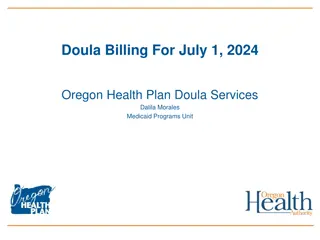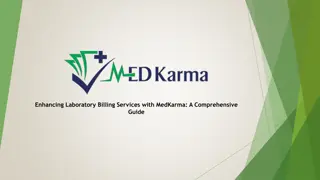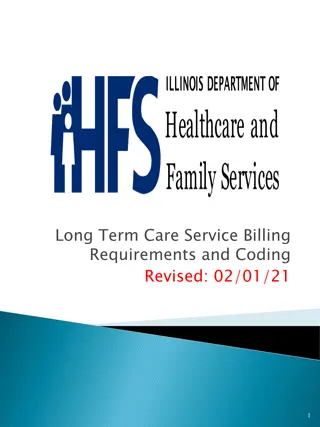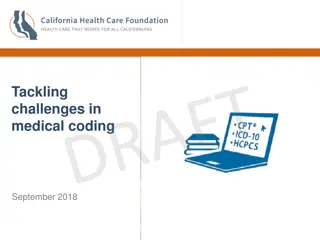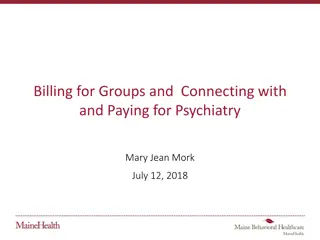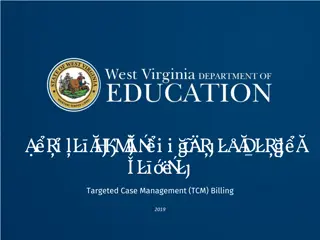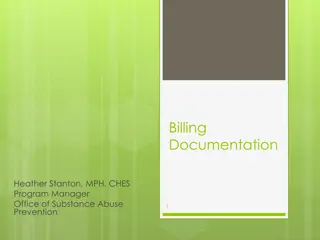Pediatric Coding and Billing Guidelines by Kim Hawkins, PhD, APRN, FNP-C
This presentation by Kim Hawkins provides essential information on pediatric coding and billing practices, including 2018 ICD-10-CM updates and principles for accurate documentation. It covers evaluation and management (E/M) coding, factors affecting E/M level of service, and distinctions between new and established patients in healthcare settings.
Download Presentation

Please find below an Image/Link to download the presentation.
The content on the website is provided AS IS for your information and personal use only. It may not be sold, licensed, or shared on other websites without obtaining consent from the author. Download presentation by click this link. If you encounter any issues during the download, it is possible that the publisher has removed the file from their server.
E N D
Presentation Transcript
CODING & BILLING IN PEDIATRICS Kim Hawkins, PhD, APRN, FNP-C, CHSE
DISCLAIMER This presentation is informational only. Please reference payer specific provider manuals for verification as well as managers or compliance officers prior to making changes to coding, documentation, and/or billing practices. https://www.cms.gov/Outreach-and-Education/Medicare-Learning-Network- MLN/MLNProducts/MLN-Publications-Items/CMS1243514.html
OBJECTIVES Review basics of billing and coding Identify 2018 ICD-10-CM updates pertinent to the pediatric visit Apply billing and coding knowledge to patient scenarios
BACKGROUND Payers require documentation that validates: Site of service Medical necessity an appropriateness of the diagnostic and/or therapeutic services provided That services furnished have been accurately reported General Principles The medical record is complete and legible Documentation includes: Reason for encounter Relevant hx/exam findings/testing Assessment/Dx Plan Date and identity of observer
EVALUATION/MANAGEMENT (E/M) CODING Level of E/M Service The most common error is lack of documentation to support your E/M coding (CPT code) NPs are more likely to under bill based on documentation Don t upcode what you didn t do Don t undercode by not taking credit for things you did do if there was a good reason for you to do it. If you didn t chart it, it wasn t done
E&M LEVEL OF SERVICE FACTORS Location of service Inpatient or outpatient? Patient type New vs. established (outpatient) Initial vs. subsequent (inpatient) Consultation vs. referral (transfer of care) Time-based codes Discharge day management Critical care
NEW VS. ESTABLISHED PATIENT 3-year rule New patient: has not received any professional services from the provider or another of the same specialty within the same group practice within the past 3 years. Established patient: has received professional services from the provider, or another of the same specialty within the same group practice within the past 3 years.
KEY COMPONENTS OF E&M SERVICES History Subjective Exam Objective Medical Decision Making Assessment and Plan of Care OR Time when counseling and coordination of care dominate the encounter
E&M HISTORY ELEMENTS Chief Complaint (CC) History of Present Illness (HPI) Review of Systems (ROS) Past Medical, Family, and Social History (PFSH)
CHIEF COMPLAINT (CC) Required for all types of History Even a -211 or -201 code mush have this documented
HISTORY OF PRESENT ILLNESS (HPI) Eight descriptions provided by the patient: Location Quality Severity Duration Timing Context Modifying factors Associates signs/symptoms
HPI 2 types of HPI: Brief: 1-3 HPI descriptors Extended: at least 4 HPI descriptors or the status of at least 3 chronic or inactive conditions
REVIEW OF SYSTEMS (ROS) 14 identified systems for problems the patient is currently experiencing: Musculoskeletal Integumentary Constitutional Neurological Eyes Psychiatric Ears, nose, mouth, throat Endocrine Cardiovascular Hematologic/lymphatic Respiratory Allergic/immunologic Gastrointestinal Genitourinary
ROS 3 types of ROS Problem pertinent inquires about the system directly related to the problem identified in the HPI Extended - + responses and pertinent negatives for 2-9 systems should be documented Complete at least 10 organ systems must be reviewed and those with + or pertinent responses must be individually documented. For the remaining systems, a notation indicating all other systems are negative is permissible.
PAST, FAMILY, & SOCIAL HISTORY PMH: patient s own hx of illness, operations, injuries, & treatments FH: review of medical events, diseases, and hereditary conditions that may place the patient at risk SH: age appropriate review of past and current activities
PAST, FAMILY, & SOCIAL HISTORY Pertinent A review of the history areas directly related to the problem(s) identified in the HPI Requires documentation from at least 1 of the 3 history areas Complete A review of 2 or all 3 history areas, depending on the category of E&M service Established office/outpatient requires 2 areas New office/outpatient, hospital observation, initial inpatient, consults, require all 3
HISTORY LEVELS History Level CC HPI ROS PFSH Estab New Estab New Estab New Estab New Problem Focused Yes 1-3 1-3 N/A 1 N/A N/A Expanded Problem Focused Yes 1-3 4+ 1 2-9 N/A 1 Detailed Yes 4 or more 4+ 2-9 10+ 1 All 3 Comprehensive Yes 4 or more 4+ 10+ 10+ 2 All 3
E&M - EXAMINATION The extent of examination performed is based upon clinical judgment, the patient s history, and the nature of the presenting problem.
EXAMINATION The level of E/M service is based on: Problem focused: a limited examination of the affected body area or organ system. Expanded Problem Focused a limited examination of the affected body area or organ system and any other symptomatic or related body area(s) or organ system(s). Detailed an extended examination of the affected body area(s) or organ system(s) and any other symptomatic or related body area(s) or organ system(s). Comprehensive a general multi-system examination, or complete examination of a single organ system and other symptomatic or related body area(s) or organ system(s).
RECOGNIZED ORGAN SYSTEMS Each line counts as an individual system (so, a total of 14 systems here) Constitutional Eyes Ears, Nose, Mouth, and Throat- all one Neck Respiratory Cardiovascular Chest (Breasts) GI (Abdomen) GU Lymphatic Musculoskeletal Skin Neurologic Psychiatric
LEVELS OF EXAMINATION Level of Exam Perform & Document Established Patient 1 area/system New Patient Problem Focused 2-4 systems 2-4 systems Expanded Problem Focused 5-7 systems 5-7 systems Detailed 8+ systems 8+ systems Comprehensive 8+ systems
E & M MEDICAL DECISION MAKING Three components The number of possible diagnoses and/or management options considered The amount and/or complexity of data ordered and/or reviewed by the provider The risk of significant complications, morbidity, and/or mortality as well as comorbidities associated with the patient s presenting problem(s), the diagnostic procedure(s), and/or the management options. (Table of Risk)
MEDICAL DECISION MAKING LEVELS TYPE OF DECISION MAKING NUMBER OF DIAGNOSES OR MANAGEMENT OPTIONS AMOUNT AND/OR COMPLEXITY OF DATA TO BE REVIEWED RISK OF SIGNIFICANT COMPLICATIONS, MORBIDITY AND/OR MORTALITY Minimal Minimal or None Minimal Straightforward Limited Limited Low Low Complexity Multiple Moderate Moderate Moderate Complexity Extensive Extensive High High Complexity
NUMBER OF DIAGNOSES/MANAGEMENT OPTIONS For a presenting problem with an established diagnosis, the record should reflect whether the problem is: Improved, well controlled, resolving, or resolved Inadequately controlled, worsening, or failing to change as expected For a presenting problem without an established diagnosis, the assessment or clinical impression may be stated in the form of differential diagnoses or as a possible, probable, or rule out diagnosis. The initiation of, or changes in, treatment (patient instructions, nursing instructions, therapies, and medications) If referrals are made, consultations requested, or advice sought, to whom or where the referral or consultation is made or from whom advice is requested
AMOUNT AND/OR COMPLEXITY OF DATA TO BE REVIEWED Based on the types of diagnostic testing ordered or reviewed including: Reviewing old medical records Discussion of contradictory or unexpected test results with the physician who performed or interpreted the test The provider who ordered a test personally reviews the image, tracing, or specimen to supplement information from the physician who prepared the test report or interpretation
RISK OF SIGNIFICANT COMPLICATIONS, MORBIDITY, AND/OR MORTALITY Based on the risks associated with: Presenting problems Diagnostic procedures Possible management options Minimal Low Moderate High
TABLE OF RISK Level of Risk Presenting Problem(s) Diagnostic Procedure(s) Ordered Management Options Selected Minimal 1 self limited or minor problem (cold, tinea) Lab requiring venipuncture CXR, EKG, US, US, KOH Rest Gargles Elastic bandages Superficial dressings Low 2 or more self limited or minor problems 1 stable chronic illness Acute uncomplicated illness or injury Physiologic tests not under stress Non-cardiovascular imaging with contrast Superficial needle bx Lab requiring arterial puncture Skin biopsies OTC drugs Minor surgery with no identified risk factors PT OT IV fluid w/o additives
TABLE OF RISK Level of Risk Presenting Problem(s) Diagnostic Procedure(s) Ordered Management Options Selected Moderate 1 or more chronic illness-mild 2 or more stable chronic illnesses Undiagnosed new problem with uncertain prognosis Acute illness with systemic symptoms Acute complicated injury Physiologic tests under stress Diagnostic endoscopies with no risk factors Deep needle or incisional bx CV imaging with contract and no risk factors Obtain fluid from body cavity Minor surgery with identified risk factors Elective major surgery with no risk factors Rx drug management Therapeutic nuclear medicine IV fluid with additives Closed tx of fx or dislocation w/o manipulation High 1 or more chronic illnesses with severe exacerbation Acute or chronic illnesses or injuries that pose a threat to life or body function An abrupt change in neurologic status CV imaging with contract with identified risk factors Cardiac electrophysiological tests Diagnostic endoscopies with identified risk factors Discography Elective major surgery with identified risk factors Emergency major surgery Parenteral controlled substances Drug therapy requiring intensive monitoring for toxicity Decision not to resuscitate or to de
LEVELS OF SERVICE Office New Patient, Consultations, Initial Inpatient Visits: Documentation must meet or exceed the requirements for all three key components Higher Levels (99204-99205, 99244-99245, 99254-99255, and 99222-99223) require:
Established Patients
TIME-BASED E&M CODES Adult critical care services Hospital discharge day management Counseling/coordination of care make up more than 50% of the encounter Time(s) must be documented in the record
CONSULTATIONS A physician, qualified NPP (non-physician practitioner), or other appropriate source requests advice, opinion, recommendation, suggestion, direction, or counsel in evaluating or treating a patient, from another physician or qualified NPP. Both the requesting and performing providers must document their understanding of the intent for a consult in their respective records.
CONSULTATIONS Three R s of a consultation Request from another physician or appropriate source, to Render advice or opinion, and Report back to the requesting provider Document the request for a consultation in the patient s chart both the requestor and the consulting provider.
ICD 10 ICD-10 updates take effect October 1st each year The ICD consists of 3-7 characters
ICD 10 PEARLS No matter what the vaccine, the diagnosis code is always the same= Z23 There is a code for the patient that presents with a potential problem, but there is no evidence of a problem and the exam is normal. Person with feared health complaint in whom no diagnosis is made (aka worried well ) = Z71.1 Single pulse ox reading 94670 Multiple pulse ox readings 94671 Administration of vaccine 90471 Administration of a 2nd vaccine, or 3rd, etc. (on same day as first) 90472 Pt teaching: Use of an Inhaler 94664 The more specific the diagnosis code, the better Choose this: Acute suppurative otitis media without spontaneous rupture of right ear drum (H66.001) instead of: Acute suppurative otitis media (H66.0) Avoid vague codes ( unspecified ) If you have >1 code, prioritize Remember to include secondary diagnoses that could influence your treatment plan Immunosuppressed state, streptococcal exposure, etc. Helpful website: www.icd10data.com
2018 ICD-10 CODING UPDATES FOR PEDIATRICS (AAP, 2017) Descriptors Avoidant/restrictive food intake disorder Codes F50.82 Codes P91.819 Descriptors Neonatal encephalopathy, unspecified M33.03 Juvenile dermatomyositis without myopathy P91.88 Other specified disturbances of cerebral status of newborn Unilateral intraabdominal testis P29.30 Pulmonary hypertension of newborn Q53.111 P29.38 Other persistent fetal circulation Q53.112 Unilateral inguinal testis P78.84 Gestational alloimmune liver disease Q53.13 Unilateral high scrotal testis P83.81 Umbilical granuloma Q53.211 Bilateral intraabdominal testes P83.88 Other specified conditions of integument specific to newborn Neonatal encephalopathy in diseases classified elsewhere Q53.212 Bilateral inguinal testes P91.811
2018 ICD-10 CODING UPDATES FOR PEDIATRICS (AAP, 2017) Descriptors Codes Codes Descriptors T14.91X- (A,D,S) Suicide attempt R06.03 Acute respiratory distress Z71.82 Exercise counseling R39.83 Unilateral non-palpable testicle Z91.841 Risk for dental caries, low R39.84 Bilateral non-palpable testicles Z91.842 Risk for dental caries, moderate T07.XXX- (A,D,S) T14.8XX- (A,D,S) Unspecified multiple injuries Z91.843 Risk for dental caries, high Other injury of unspecified body region Z91.849 Unspecified risk for dental caries T14.90X- (A,D,S) Injury, unspecified
PRACTICE Biographical data: 4 year old Caucasian male, mother is reliable historian CC: His ear has been bothering him HPI: Per mother patient has had pain in his left ear for the past 2 days. It seems to be getting worse, especially when he lays down to sleep. Reports a fever of 102.0 this morning. ROS: ENT: + nasal congestion, denies sore throat Respiratory: + nonproductive cough, denies difficulty breathing PFSH: No smokers in the home, attends daycare, no medications or allergies PE: Left TM erythematous with purulent effusion noted, no visible landmarks, poor TM mobility. Right TM normal. Tan nasal discharge noted. Posterior pharynx without erythema or drainage. Mild anterior cervical lymphadenopathy. Lungs clear. Heart regular with out murmurs.

 undefined
undefined



